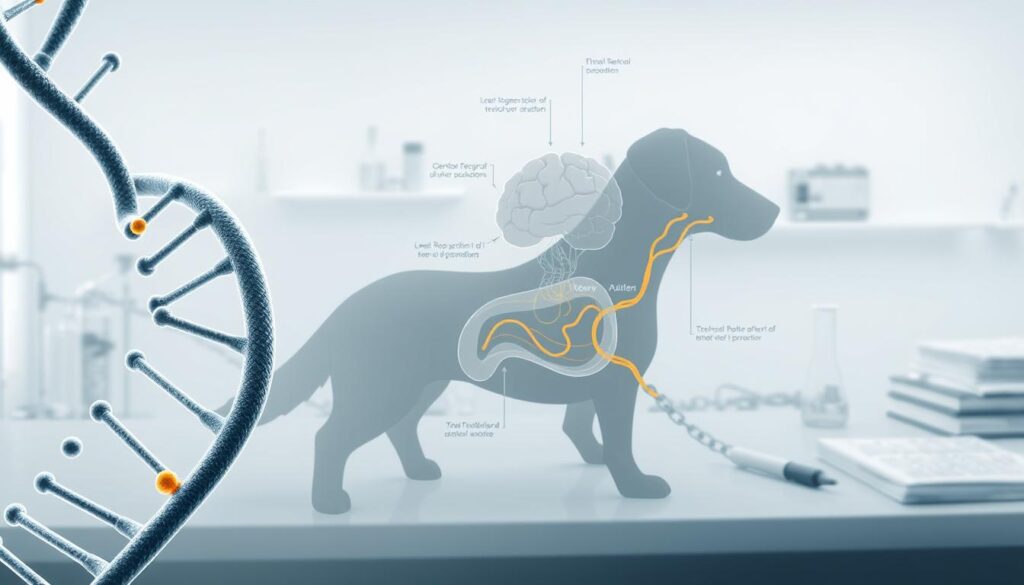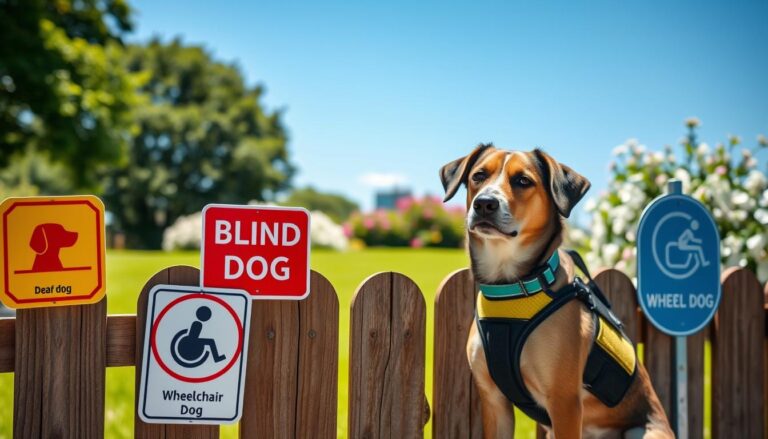Autistic Dog: How to Recognize the Symptoms
When my rescue dog Max first came home, I noticed something different. His unusual behaviors weren’t just quirks – they were signals of something deeper. Understanding an autistic dog isn’t about labeling, but about compassion and specialized care.
Dogs can’t be clinically diagnosed with autism like humans. But, some dogs show behaviors that look like autism. Veterinarians call this Canine Dysfunctional Behavior (CDB), a complex condition needing careful observation and understanding.
Your dog might show unique ways of interacting or be very sensitive to sounds and sights. Spotting these signs early helps you offer the right support. It also creates a caring space for your autistic dog to flourish.
Dog autism isn’t a formal medical term. It’s a way to describe certain behaviors that affect how your pet interacts, communicates, and reacts to the world. Knowing these behaviors can change how you care for your special pet.
This guide will help you spot autism-like behaviors in dogs. It aims to give you a deeper understanding of your pet’s unique brain.
Table of Contents
Understanding Canine Behavioral Disorders
Dogs can face complex behavioral challenges that go beyond simple training issues. Canine autism, though different from human autism, is a recognized set of behaviors by vets and animal behaviorists.
To understand autism in dogs, we must explore their neurological and behavioral traits. These disorders show unique patterns that set them apart from common behavioral problems.
Defining Neurodevelopmental Disorders in Dogs
Neurodevelopmental disorders in dogs often include:
- Atypical social interaction patterns
- Repetitive behavioral sequences
- Heightened sensory sensitivity
- Challenges in environmental adaptation
The Role of Brain Development
Brain development is key in shaping a dog’s behavior. Neurological variations affect how a dog processes info, interacts, and communicates.
“Not all behavioral differences indicate a disorder, but understanding subtle neurological nuances can help pet owners provide better care.” – Dr. Sarah Thompson, Veterinary Behaviorist
Impact on Social Behavior
Dogs with canine autism may find social interactions hard. They might show:
- Reduced eye contact
- Limited interest in play
- Difficulty reading social cues
- Preference for solitary activities
Spotting these signs early can help owners improve their dog’s life.
Can Dogs Really Have Autism?
Looking into signs of autism in dogs means studying their behavior closely. Dogs can’t get autism like people do, but vets see some behaviors that look like it. These behaviors can affect how a dog acts and interacts with others.
Vets call these behaviors Canine Dysfunctional Behavior (CDB). It’s like a dog version of autism. These behaviors can really change how a dog lives and interacts with others.
- Dogs may display repetitive behaviors
- Some dogs struggle with social communication
- Sensory sensitivities can be observed in certain canines
Studies show dogs can have neurological differences. These differences can make it hard for them to act normally around people and other animals. These signs in dogs aren’t exactly like human autism. But they do show unique challenges that need special care.
Veterinary behaviorists emphasize the importance of comprehensive assessment when identifying potential neurological differences in dogs.
Your vet can tell if a dog’s behavior is just different or if it’s a bigger issue. Knowing about these special behaviors helps us take better care of dogs with unique challenges.
Signs of an Autistic Dog
Spotting autism-like traits in dogs needs careful watching and knowing. It’s key for pet owners to grasp their dog’s special ways of acting.
Dogs with autism-like traits show unique signs. These traits differ from usual dog behavior. They can change how dogs act with others, talk, and react.
Social Interaction Challenges
Dogs with autism-like traits find it hard to connect with others. You might see your dog:
- Avoiding eye contact
- Showing little interest in people or animals
- Seeming out of place during play or with others
Repetitive Behaviors
Recognizing repetitive actions is part of autism awareness in dogs. These actions might show neurological differences:
- Chasing their tail over and over
- Always lining up objects
- Chewing or spinning compulsively
Sensory Sensitivities
Some dogs with autism-like traits are very sensitive to their senses. They might react strongly to:
| Sensory Trigger | Potential Reaction |
|---|---|
| Loud Sounds | Extreme anxiety or shutdown |
| Specific Textures | Avoidance or distress |
| Visual Stimuli | Overwhelming response |
Knowing these signs helps you support and care for a dog with autism-like traits better.
The Science Behind Canine Behavioral Issues
To treat autism in dogs, we need to understand their brain and genes. Researchers have found links between brain growth and dog behavior. This helps us grasp unique neurological conditions.
Autism-like behaviors in dogs come from many factors:
- Genetic predispositions
- Neurological development challenges
- Early life experiences
- Environmental interactions
Dogs’ brains are key to how they understand social cues. Mirror neurons, special brain cells, help dogs learn by watching. They are crucial for a dog’s social skills.
| Neurological Factor | Potential Impact on Behavior |
|---|---|
| Reduced Mirror Neuron Activity | Decreased social learning capacity |
| Altered Neural Connectivity | Challenges in social interaction |
| Sensory Processing Differences | Heightened environmental sensitivity |
Veterinary behaviorists say it’s key to know about these brain differences. Each dog’s genes and life experiences shape their behavior.
Common Traits of Dogs with Autism-Like Behaviors
Understanding dogs with autism-like behaviors is key for pet owners. These dogs show unique traits that differ from regular dogs.
Dogs with autism-like traits have specific behaviors. They need careful observation and special support.
Communication Patterns
Communication is a big part of understanding these dogs. They might:
- Not make eye contact with humans or other animals
- Not respond well to verbal commands
- Interact less with other dogs
- Have trouble showing emotions through body language
Response to Environmental Changes
These dogs are very sensitive to their environment. They often:
- Get anxious when things change
- React strongly to sudden noises or movements
- Like things to stay the same and predictable
Physical Manifestations
Physical behaviors can give clues about autism-like conditions:
| Behavior Type | Typical Manifestations |
|---|---|
| Repetitive Movements | Tail chasing, circling, pacing |
| Sensory Sensitivities | Overreacting to touch, sound, or sight |
| Compulsive Actions | Constantly lining up objects, chewing obsessively |
Spotting these traits early helps you support your dog better.
Genetic and Environmental Factors

To understand autism in dogs, we must look at how genes and environment work together. Studies show that some dogs might be more likely to show autism-like behaviors. This is because of certain genes and how their brains are wired.
Genes are key in autism-like behaviors in dogs. Some breeds are more likely to have these behaviors because of their genes:
- Neurological variations that affect social interaction
- Genetic mutations impacting brain development
- Inherited sensory processing differences
Environment also plays a big role in a dog’s behavior. Dogs with autism-like traits face big challenges early on:
| Environmental Factor | Potential Impact |
|---|---|
| Early Socialization | Critical for behavioral development |
| Maternal Stress | Can influence neurological patterns |
| Traumatic Experiences | May trigger behavioral sensitivities |
Your dog’s genes and life experiences shape their behavior. Veterinary professionals say autism in dogs is not the same for everyone. Each dog needs their own care and understanding.
The mix of genes and environment makes a complex picture of canine behavior.
Professional Diagnosis and Assessment
Spotting autism in dogs needs a detailed and expert approach. Vets use special methods to grasp unique behaviors that might show neurodevelopmental differences.
Assessment involves complex strategies to check for autism-like traits in dogs. It’s a detailed task that needs the skills of specialized vet behaviorists.
Veterinary Evaluation Process
Vets do deep assessments to look for autism signs in dogs. They check:
- Comprehensive physical exams
- Detailed reviews of a dog’s behavior history
- Neurological tests
- Genetic background checks
Behavioral Testing Methods
Special tests help figure out neurodevelopmental issues by looking at:
- How dogs react to social interactions
- How sensitive they are to sounds and touch
- Repetitive actions
- How well they communicate
Ruling Out Other Conditions
Vets work hard to tell autism from other brain or anxiety issues. Precise diagnostic techniques help find out why dogs act differently.
Getting a correct diagnosis needs careful watching and vet help.
Professional checks make sure dogs get the right care for their unique brain experiences.
Treatment Options and Management Strategies
Treating autism in dogs needs a caring and detailed approach. Each dog is different, so their treatment must be too. Getting help from a vet behaviorist is key to making a good plan.
There are important steps to help dogs with autism live better:
- Create a structured and predictable daily routine
- Implement positive reinforcement training techniques
- Develop sensory-friendly environments
- Use specialized behavioral modification approaches
Behavioral treatments are vital for managing dog behavior issues. Your vet might suggest:
- Consistent training methods that reduce anxiety
- Environmental enrichment activities
- Carefully designed sensory experiences
- Potential medication for severe symptoms
Mental stimulation is key for dogs with autism. Puzzle toys, controlled social interactions, and patient training help them cope better. Remember, progress might be slow, so patience is crucial.
Each dog’s journey is unique, and what works for one might not work for another.
Behavioral specialists can offer custom treatments for your dog. They help with social interactions and stress responses.
Creating a Supportive Environment
Supporting autistic dogs needs careful planning and understanding their special needs. Dogs with autism-like traits need special care to feel safe and at ease at home.

To create a safe and caring space, several important strategies can greatly enhance your dog’s life.
Establishing Consistent Routines
Routine is key for dogs with autism-like behaviors. A set schedule can lessen anxiety and give them a sense of safety. Here are some ways to build routines:
- Feed your dog at the same times each day
- Create a consistent walking and exercise schedule
- Maintain regular bedtime and wake-up times
- Use visual cues or calendars to reinforce daily patterns
Sensory Considerations
Sensory sensitivity is a big part of supporting autistic dogs. They might get overwhelmed by certain things, so managing their environment is crucial.
- Minimize loud noises
- Use soft, gentle lighting
- Provide noise-canceling products
- Create calm, quiet spaces
Safe Spaces and Comfort Zones
Make a special area in your home for your dog to go when stressed. This spot should be:
- Quiet and away from busy areas
- Equipped with comfy bedding
- Filled with familiar toys
- Easily accessible to your dog
By using these supportive strategies, you can make your autistic dog feel safer and more comfortable every day.
Working with Animal Behaviorists
Understanding autism in dogs needs special help. Animal behaviorists are key in helping you manage your dog’s unique behaviors. They offer advice that fits your dog’s needs, helping you find ways to communicate and support them better.
Animal behaviorists take a detailed approach to tackle autism-like behaviors in dogs. They do thorough assessments to figure out what triggers your dog’s reactions and how they communicate.
- Conduct in-depth behavioral evaluations
- Design personalized intervention plans
- Teach specialized training techniques
- Provide ongoing support and guidance
The process of changing behaviors includes several important steps:
- Desensitization: Slowly introducing your dog to things that scare them
- Counterconditioning: Changing negative reactions to positive ones
- Teaching ways to handle sensory issues
Your behaviorist will work with you to create a supportive space. They know that helping dogs with autism needs patience, special knowledge, and kindness. This helps your dog do well.
Daily Life with an Autistic Dog
Living with a dog with canine autism needs patience, understanding, and special care. Your dog might act differently, needing a kind approach in daily life.
Managing daily life with an autistic dog involves several strategies:
- Create consistent daily schedules
- Minimize sudden environmental changes
- Develop calm interaction techniques
- Recognize individual stress triggers
Your dog might not want to play as much or seem less energetic. This is common in dogs with autism-like traits. Having set routines makes your pet feel safe and happy.
Good communication is key when dealing with canine autism. Learn to understand your dog’s body language and respect their space. Some dogs might not like being touched a lot or get scared by loud noises.
“Understanding your dog’s unique needs is the foundation of creating a supportive environment.”
Sensory sensitivities are important for your dog’s daily life. Give them quiet places to go when stressed. Use gentle training techniques that reward good behavior and avoid punishment.
Every dog with canine autism is different. Working with vets and animal behaviorists can help you find the best ways to support your dog.
Conclusion
Dealing with dog autism needs patience, understanding, and special care. It’s complex, but knowing and tackling behavioral issues can really help your pet. Getting help from experts is key to finding ways to manage their differences.
When facing dog autism, aim to create a supportive space with less stress. Every dog with autism is different, so they need care that fits them. Working with vets and animal behaviorists helps create plans that work for your dog.
Getting to know dog autism means accepting and understanding your pet’s unique ways. New studies are helping us learn more about their brains. Stay open and caring, knowing that with the right support, dogs with autism can be happy and fulfilled.
Your dedication to understanding your dog’s special needs can turn challenges into chances for a stronger bond. Use professional advice, keep learning, and show endless love. This helps your dog feel secure and comfortable in their world.







